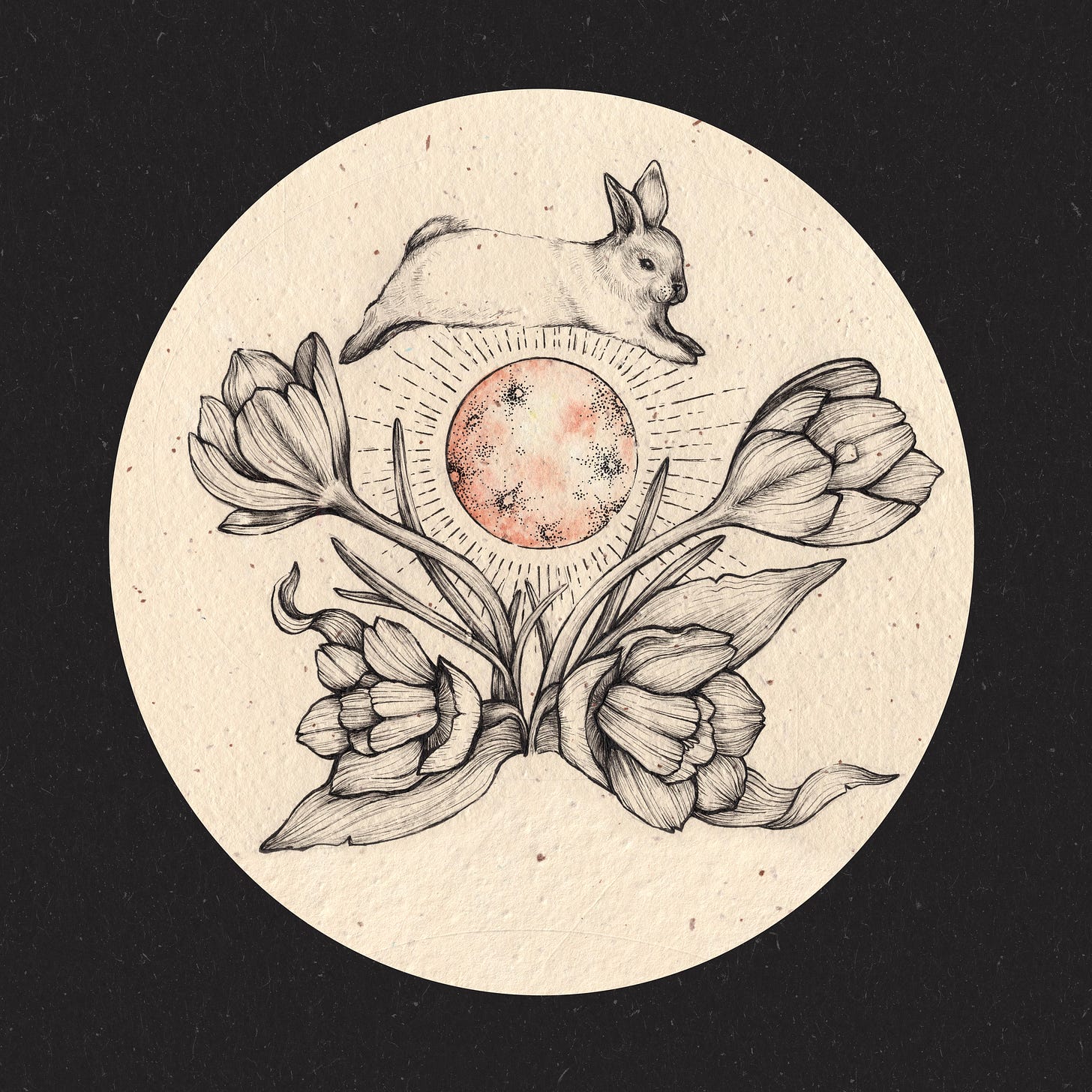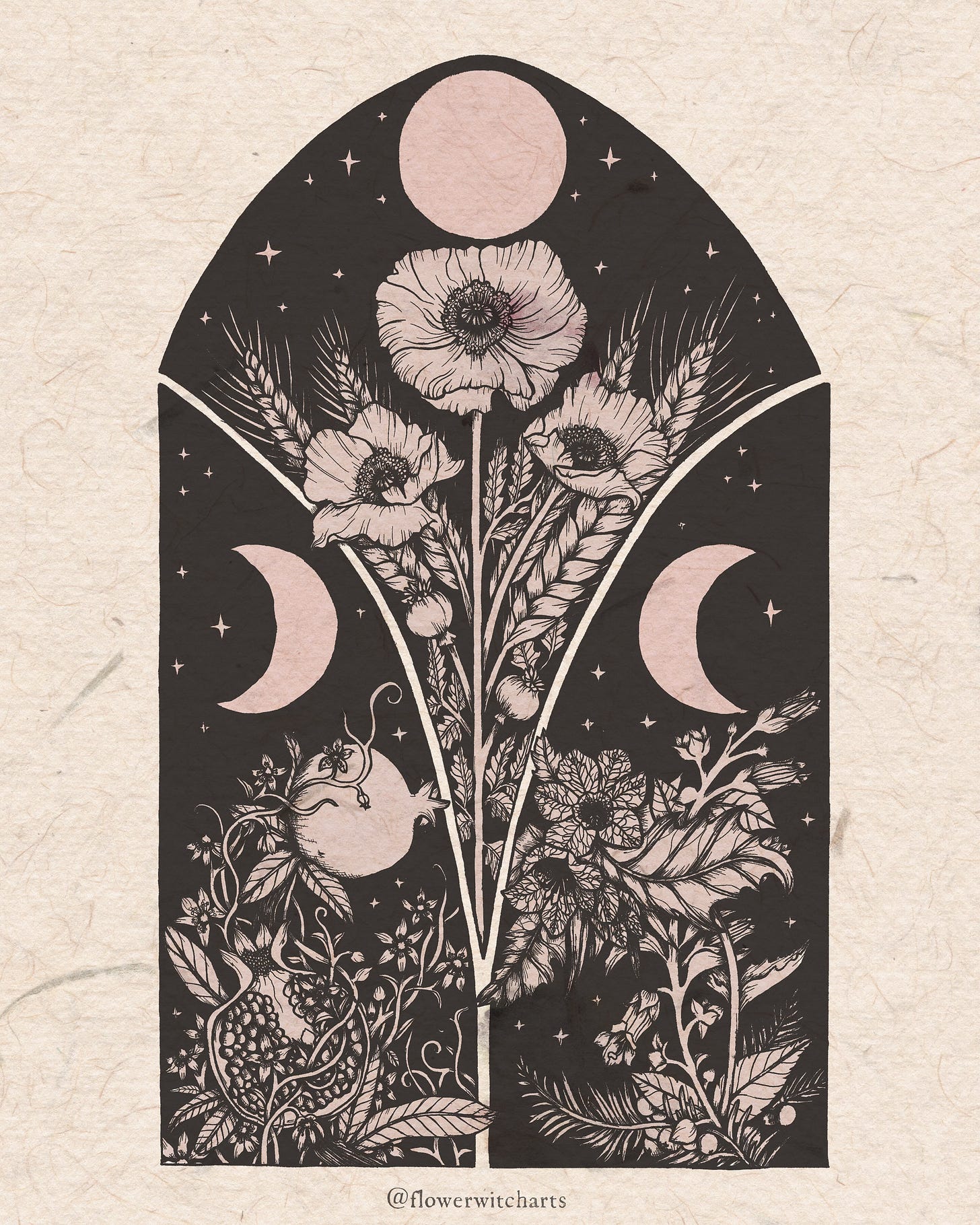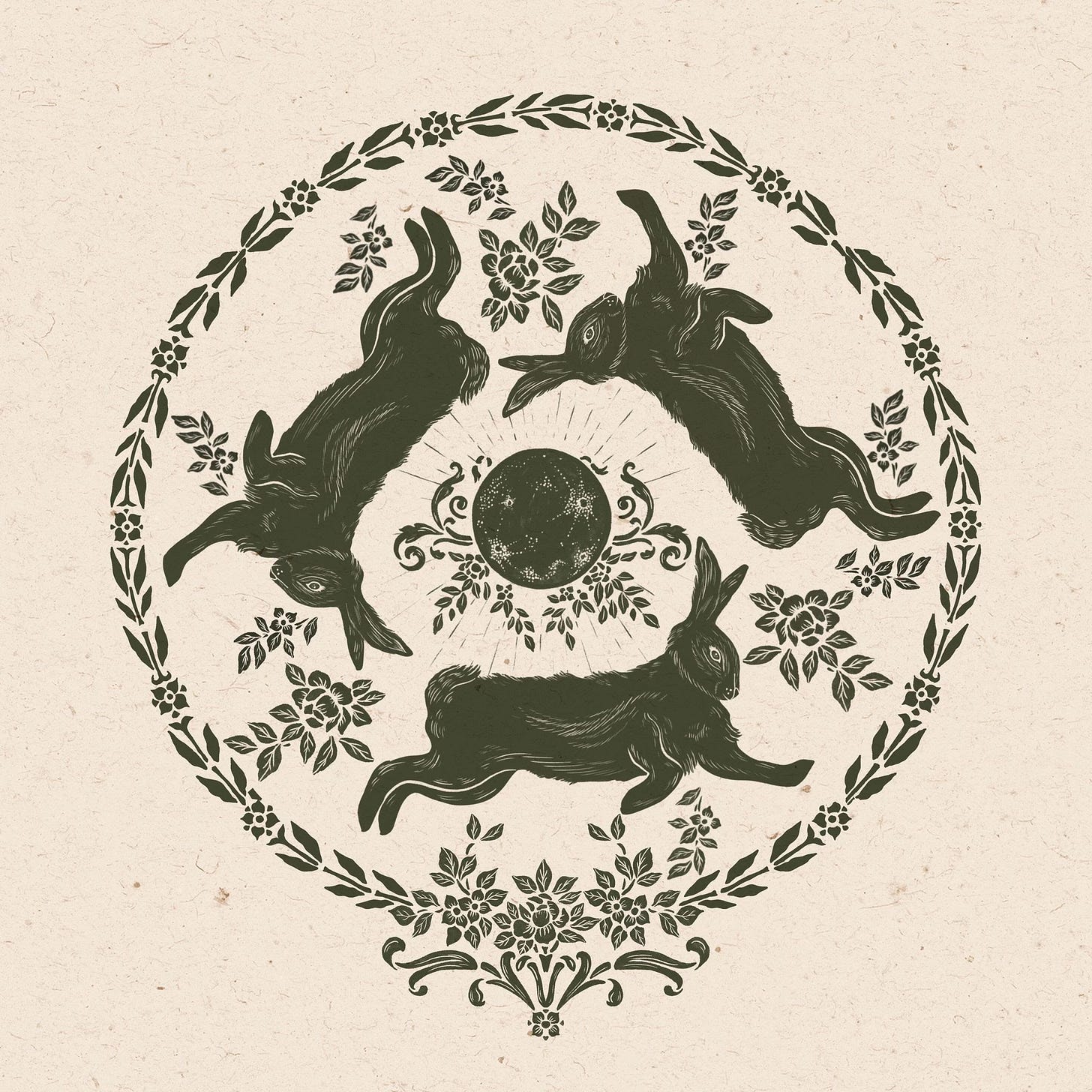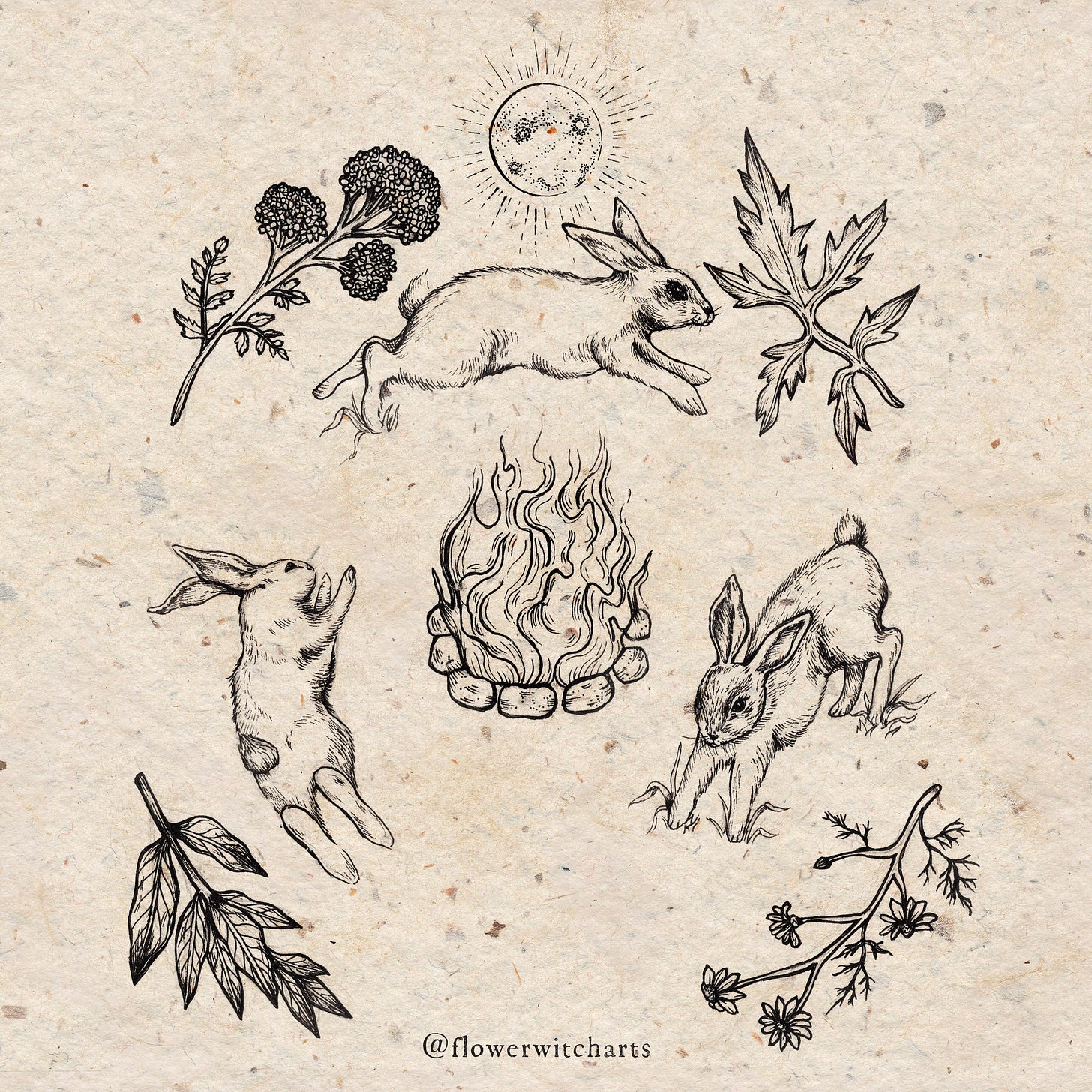Not one hare but three, eyes toward the moon,
Like moths to a flame, it’s easy to assume,
Nobody knows a witch, without her trusty broom,
Shapeshifting trinity — let the Hare’s Parliament resume.
— The Witch’s Secret: An Ode to the Hare

Cloaked in saffron and flanked by spectral hounds, Hecate is the mythical goddess of witchcraft and the moon. In stories, she's a guardian and gardener, tending to poisonous plants and the blossoms that frame shadowy thresholds and opportunities.
When one of Hecate’s flowers unfurls in our path, consider it a 'hello' from the Below or a supernatural wink. As a crossroads deity, Hecate oversees seasonal junctures, be they equinoxes, solstices, or the moon's journey from empty to full.
Whispering from her earthen altar, Hecate returns to the wild places in spring. Masked in moonlit prayers, her arrival is marked by crocus flowers and the return of the springtime goddess, Persephone. Beneath this full moon, our third of the year, Hecate teaches us about resurrection, her crossroads, and following the hasty tracks of the Hare…
Hecate & the Crocus
Hecate is a gardener of plants and mystery, unmatched in her knowing of seasons and cycles. She's skilled in field magick and floromancy (divination with flowers), and her wisdom permeates from petal to root. Although she is celestial, born from the stars, Hecate planted her heart in the gardens of humanity. Even as a child, Hecate understood that a handful of dirt was as precious as stardust.
Triform and with a torch in hand, Hecate uses her connective influence to unite worlds. For centuries, she's served as a messenger between sky and sea and the places in between. When not in her cave or charioting through the stars, Hecate dwells in her soil sanctuary, a realm of darkness and transformation. She is partial to many plants, including datura, mandrake, henbane, garlic, and crocus blossoms.

In the Homeric Hymn to Demeter, Hecate is good friends with Demeter and her daughter, Kore. From her mountain cave, Hecate watches Kore piece together a bouquet of rose, violet, and crocus flowers before plucking the single narcissus that casts a cloud of sorrow over the perfect spring day. A black carriage emerges from a hole in the earth, and without explanation, it chariots Kore to the Underworld. No longer an embodiment of spring, Kore is now Persephone, Queen of the Dead and partner to Hades.
According to the language of flowers, the crocus is a harbinger of change, but it’s also a messenger of resurrection, with certain varieties blooming in autumn when the rest of the garden has gone to seed.
The Fate of Persephone, Walter Crane, 1877
As the story goes, Kore's been missing for months, and Demeter is inconsolable. In her daughter's absence, the goddess of grain blights all the plants and once-beautiful meadows, and a permanent winter takes hold of the earth. Nothing will grow, not grass nor wheat, but miraculously, a patch of crocus flowers sprouts between the feet of the mourning woman. Demeter is moments away from smothering the flowers with her grief, but they beg her to wait, for they carry an important message – “Kore is returning home!” they promise. “Hermes went to her this morning; we can hear their footsteps just beyond the ridge!”
Some might say that it wasn't a bed of crocus flowers but the goddess Hecate who prophesized Persephone's return. In poetry, Hecate is 'saffron-cloaked, ' referring to the crocus flower, also known as saffron crocus or Crocus sativus. Saffron-colored frocks were symbols of divinity and were also worn by Artemis, the Maenads, and the goddess of Dawn. Like the flower, these goddesses were beacons of hope in otherwise dire situations.
Diana and the Tripled-Faced Hecate with Pegasus, Francesco Primaticcio, 16th century
Hecate & the Hare
Not solely dedicated to flowers but also to the creatures that roam our gardens, we'll also find bees, deer, and hares darting throughout the pages of spring folklore. We talked about bees here and here and deer here, but their friend, the archetypal Hare, illustrates fertility, love, and a quick, clever spirit. Sometimes, this creature is a trickster in stories or a witch in disguise. In years past, people believed witches shapeshifted into hares to evade capture and protect their true identity.
A gathering of hares is called a Hares Parliament, and even today, rumor says this isn't a meeting between animals, but a gathering of witches. Some of us might identify Hecate with this swift messenger, and if we do, she likely goes by the name Harek. A rabbit-faced deity, Harek was believed to be Hecate's German equivalent, and instead of hounds, she was flanked by hares. Like dogs, Hares have long been associated with the moon and the Underworld, sometimes serving as its protector. Followers of the mythical hare would carve its image into an amulet and wear it for agility, prophetic insight, and abundance.

Though the hare has appeared throughout mythologies for thousands of years, none is as intriguing as The Hare's Trinity (also known as the Three Hares) for the three creatures chasing the tail of their neighbor.
Despite the widespread appearance of this design throughout culture and myth, its exact purpose remains a mystery. Some suggest The Hare's Trinity is simply a puzzle of perception or an optical illusion created by the animals' shared ears, as we see in the riddle and image below.
‘Three Hares sharing three ears,
Yet every one of them has two.’’
— German riddle, 17th century
Hasendrei/Hare's Trinity target in the Deutsches Jagdmuseum
Others focus on the triangle formed by the conjoined ears and make connections to the moon and ancient moon cults. The Three Hares have also been linked with seasonal deities and holy trinities, triform goddesses like Hecate and their ancient secrets to regeneration, and the crossroads.
D. J Conway describes Hecate as a moon and underworld deity who steered a chariot pulled by dragons. She was the oldest Greek form of the triform Goddess, who ruled heaven, the Underworld, and the Earth.
“After the matriarchs fell, the Greeks worshipped Hecate only as queen of the underworld and ruler of three-way crossroads. As Hecate Trevia, Hecate of the Three Waitys, Her images stood at these crossroads where offerings of dogs, honey, and black ewe lambs were left on Full Moon nights. Divination and communication with the dead were performed in these places.”
— Maiden, Mother, Crone: The Myth & Reality of the Triple Goddess, D.J. Conway
The Key of Solomon says that the best places to perform magical rites were crossroads because of the “depth and silence of the night.” Modern practitioners utilize the crossroads for its liminal nature, either composting their worries or summoning unseen muses and messengers at Hecate’s holy haunt.
Drawing of a marble statue of Hecate Trimorph, Richard Cosway, 18th century
Starting in April, Pointy Hat Press co-founder Kristin Lisenby invites you to join her at The Crossroads — a seasonal writing community and program hosted alongside Word Witch Kate Belew! At The Crossroads, the stories of six goddesses, plants, and symbols await. Together, you’ll build altars for Aphrodite, Maia, Hera, Artemis, Demeter, & Persephone. You’ll journey to the Garden of the Hesperides, the Pleiades, and the Eleusinian Mysteries. You’ll pen invocations to the Tree Women, the Belly Goddess, the blooming flowers, and the crossroads of creativity. Keep an eye on Kristin and Kate’s Substacks as the Spring Equinox nears for more information.












Thank you very much enjoyed your weaving of words, myth and wonder.
adored this piece. gonna find some rabbits for my altar. thank you <3